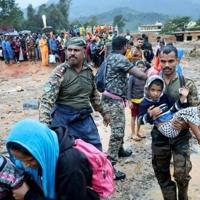Search operations for survivors of landslides in Indian tea plantations were hindered by relentless downpours and strong winds on Wednesday. The disasters have claimed the lives of 126 people, mostly believed to be labourers and their families.
Continuous heavy monsoon rains have been affecting the southern coastal state of Kerala, with blocked roads making it challenging for relief efforts in the disaster-stricken Wayanad district.
Due to the collapse of the only bridge connecting severely affected villages like Chooralmala and Mundakkai, rescue teams had to use a makeshift zipline over flooded waters to transport bodies out of the disaster area.
Some survivors who managed to escape the landslides found themselves engulfed by a nearby river that had overflowed due to the heavy rains, as recounted by volunteer rescuer Arun Dev at a hospital where survivors were being treated.
“Those who were lucky to survive were swept away by the rushing floodwaters along with their homes, temples, and schools,” he said.
Wayanad is renowned for its tea plantations spread across its hilly terrain, which heavily rely on a large workforce for plantation and harvest activities.
Multiple plantations were struck by two successive landslides early on Tuesday morning.
A number of housing units built for seasonal workers were flooded by a powerful landslide, trapping labourers and their families inside as they slept. Other structures were covered in mud and debris, with cars and metal scattered across the disaster site
An official from Wayanad district, speaking anonymously to AFP, reported that 126 bodies have been recovered so far, with the death toll expected to rise.
Over 3,000 individuals are seeking shelter in emergency relief camps across Wayanad district, as confirmed by the state government.
Chief Minister Pinarayi Vijayan mentioned that 572 millimeters of rain fell in the two days leading up to the landslides.
More rain and strong winds are predicted for Thursday in Kerala, increasing the likelihood of further damage to unstable structures, as per Kerala’s disaster agency.
– ‘Adverse weather conditions’ –
Indian opposition leader Rahul Gandhi, who previously represented Wayanad in parliament, expressed his inability to visit the disaster site due to severe weather conditions.
“We have been informed by authorities that we will not be able to land due to incessant rains and adverse weather conditions,” he shared on the social media platform X.
“Our thoughts are with the people of Wayanad during this challenging period,” he added.
Monsoon rains from June to September offer a welcome respite from the summer heat and are crucial for replenishing water supplies, agriculture, and millions of farmers’ livelihoods. However, they also bring destructive consequences such as landslides and floods.
The frequency of fatal floods and landslides has been rising, with experts attributing this increase to climate change.
“Climate change-induced heavy rainfall disasters like landslides are becoming more common in India,” Kartiki Negi from Indian environment think tank Climate Trends told AFP, highlighting India’s susceptibility to such impacts in the future.
Various human activities including damming, deforestation, and development projects have worsened the impact of natural disasters in India.
In recent months, intense monsoon storms led to flooding in Mumbai, while lightning strikes in Bihar claimed lives. In 2018, Kerala faced devastating floods that resulted in nearly 500 casualties.
One of India’s most tragic landslides occurred in 1998, when heavy monsoon rains triggered rockfalls that buried the village of Malpa in the Himalayas, claiming the lives of at least 220 individuals.
ash/gle/cwl





